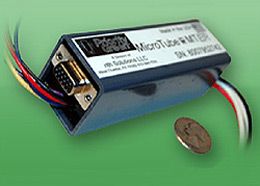By Keith Bowers
FireRescue1 Staff
 Photo courtesy of Priority Green |
Navigating intersections can be the most dangerous and time-consuming part of emergency responses, and when lives are potentially at stake, every second counts.
Statistics show that about 30 percent of firefighter deaths every year involve traffic accidents.
A company called Priority Green aims to shorten response time while keeping firefighters and other emergency personnel safe by literally giving them the green light.
The concept is called traffic-signal pre-emption: Devices mounted on apparatus electronically communicate with signals as they approach, changing the light to green or keeping it in that position if it’s there already.
Depending on factors including weather conditions, terrain and the type of device used, the optically based systems can have a range of close to half a mile, according to Priority Green President Eric Canfield.
“All we’re looking to do is give them one more advantage,” said Canfield, whose West Chester, Pa., company is one of several making such devices.
Confirmation light
In order for pre-emption to work properly, traffic signals must be outfitted with a detector and a “confirmation light” that illuminates to tell the officers that the signal was received. Canfield points out that the equipment isn’t that noticeable, and a lot of people have probably seen it but not known what it was or thought much about it.
Communities across the nation have been installing such equipment at intersections to varying degrees in recent years, Canfield said, and regulation of the systems differs by state.
He estimates that between 50 percent and 60 percent of intersections in the United States are outfitted for pre-emption. Suburban areas are the most common place to find pre-emption technology, Canfield said.
The two manufacturers of pre-emption and receiving equipment are 3M and Tomar, Canfield said, and Priority Green transmitters are compatible with either system.
Canfield said the system has built-in measures to minimize confusion and missteps at intersections by civilian drivers.
Each state has a protocol for “lockout time” — the time between when a signal changes to green and when it can change back to yellow and then red. This, Canfield explained, is because when a driver gets a green light, he or she tends not to look at the signal again for 3 to 5 seconds.
What’s more, the confirmation light not only tells the user the system has been activated but it also tell motorists that something unusual is afoot, and they’re more likely to be alert and notice emergency vehicles.
Although Priority Green makes it easier to get through intersections, it’s not a guarantee that all is clear, and apparatus drivers should never assume as much.
Restricted use
Many police departments also use the device, and restrict the use of pre-emption to vehicles that are using lights and siren, Canfield said, but some cities and counties restrict their use solely to fire vehicles.
With noise-reduction technology in late-model vehicles as well as the prevalence of tinted windows, police and fire crews are already at a distinct disadvantage with regard to being noticed compared with 10 or 15 years ago.
Numerous local, state and federal laws prohibit the use of pre-emption technology by the general public, and Priority Green sells its pre-emption products only to entities authorized to use them.
One manufacturer, Canfield said, sold devices to anyone who would pay, leading to stricter penalties for possession.
Canfield said Priority Green products are easy to install and service, and have built-in self-diagnostics, going through a number of checks on startup and repeating several while running.
If something is wrong, a light near the activation switch will flash at varying intervals depending on the problem.
“You want to know if you’ve got a problem,” Canfield said, “because you’re going to drive differently if you’ve got a problem.”
Priority Green will keep traffic signals in place as long as the user needs, but it also has an automatic shut-off option that activates when a vehicle stops.
This feature can be wired to brake or transmission lines, but if doing so voids vehicle warranties, Priority Green has an optional module that lets the system “get to know” a vehicle and when to shut off.











